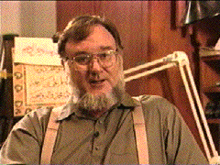Mohamed Zakariya

Mohamed Zakariya (born 1942 in Ventura, California[1]) is an American master Arabic calligrapher and an American Muslim convert.
Biography
[edit]Mohamed Zakariya was born in 1942 in Ventura, California, the son of art director Emrich Nicholson and Amy Aplin.[2][3] Later he moved to Los Angeles with his family. Zakariya saw Islamic calligraphy for the first time in the window of an Armenian carpet store in Los Angeles.[1] Zakariya traveled to Morocco in his late teens where he became fascinated with Islam and Islamic Calligraphy.[1] After returning from his trip to the United States he converted to Islam.[1]
Zakariya studied manuscripts in the British Museum. He then studied with the Egyptian calligrapher Abdussalam Ali-Nour. Afterward, in 1984, he traveled to Istanbul and became a student of the Turkish master calligrapher Hasan Celebi. He received his diploma from Celebi in 1988 at the Research Center of Islamic History, Art, and Culture in Istanbul. He is the first American to receive this honor. In 1997, he received his second diploma, in the ta'liq script, from the master calligrapher Ali Alparslan.[1]
From 2004 to 2012, Zakariya was a member of the Joint Advisory Board, Virginia Commonwealth University School of the Arts in Qatar. He was awarded an Honorary Doctorate of Humane Letters by the university in 2012.[4][5]
Students worldwide travel to the United States to study under Zakariya.[1]
Calligraphy
[edit]Zakariya's work is held in private collections and some public collections. He designed a postage stamp for the United States Postal Service to commemorate Eids (Eid al-Fitr and Eid al-Adha), which appeared in all editions issued to date.[6][7] In 2009, US president Barack Obama commissioned Mohamed Zakariya to create a piece of calligraphy that was presented to the king of Saudi Arabia.[1]
References
[edit]- ^ a b c d e f g Hussain, Amir (2014). "Mohamed Zakariya". In Oxtoby, Willard Gurdon; Hussain, Amir; Amore, Roy C. (eds.). World religions. Western traditions (Fourth ed.). Canada: Oxford University Press. p. 277. ISBN 978-0-19-900287-0. OCLC 862545152.
- ^ "Art talent took Venturan to many places, careers", Ventura County Star (Ventura CA) March 9, 2001, p.17
- ^ Kitses p.132
- ^ "Saudi Aramco World : The World of Mohamed Zakariya". archive.aramcoworld.com. Retrieved 2020-07-08.
- ^ Atil, Esin (2006). Mohamed Zakariya Islamic Calligrapher. Bellevue, WA: Bellevue Arts Museum. pp. 12–32. ISBN 0-942342-14-3.
- ^ "U.S. Muslims Push Stamp As Symbol of Acceptance", The New York Times, By LAURIE GOODSTEIN, NOV. 20, 2001
- ^ "Eid Greetings Stamp | USPS.com". store.usps.com. Retrieved 2020-07-07.
General references
[edit]- "The Soul Searcher", Psychology Today, May/June 2004.
- "The World of Mohamed Zakariya", Saudi Aramco, January/February 1992.
External links
[edit]| International | |
|---|---|
| National | |
| Other | |
Text is available under the CC BY-SA 4.0 license; additional terms may apply.
Images, videos and audio are available under their respective licenses.
